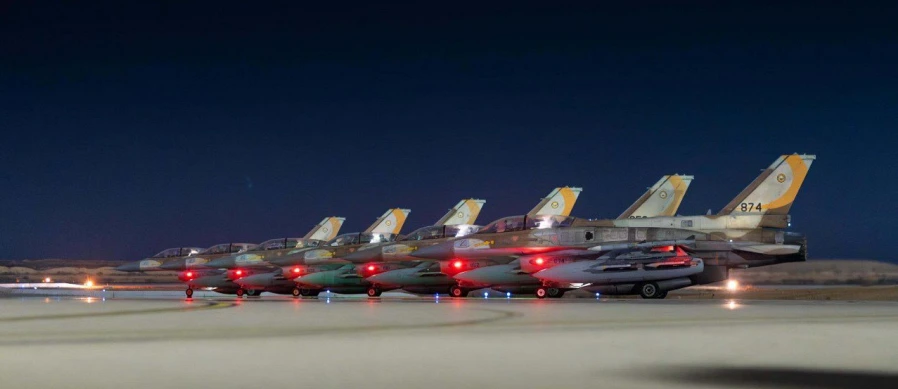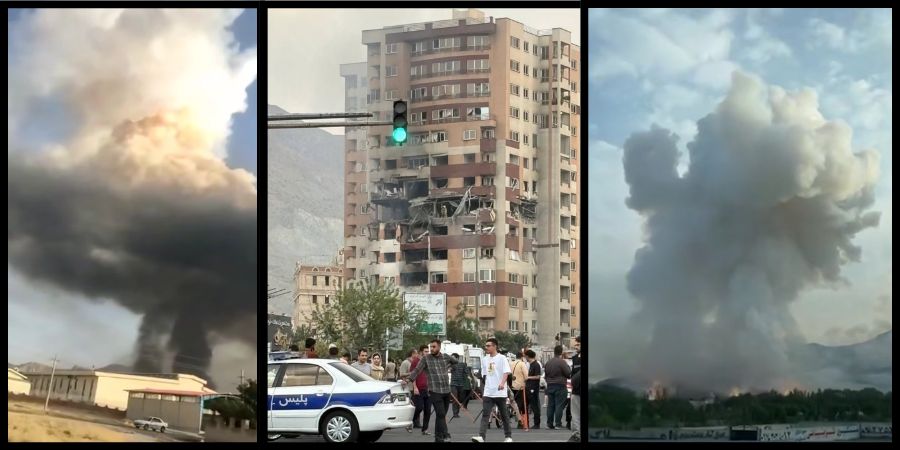For decades, Iran has invested enormous sums in building military and nuclear infrastructure to become a regional power with nuclear capabilities and also – to bring about the elimination of the State of Israel. Budgets flowed, facilities were established, proxies were activated, missiles were produced – but in the very early morning hours of Friday, June 13, 2025, the picture changed.
What was previously an ongoing confrontation between Iran and Israel through proxies became a direct war between the two countries, as Israel deployed ‘the real thing’ – an extensive preemptive attack under the name “Operation Rising Lion,” planned over years, which struck infrastructure, nuclear facilities, ballistic missiles, and heads of the nuclear project and Revolutionary Guards.

Under the guidance of the political echelon, the IDF launched a precise and integrated attack based on high-quality intelligence. The objective, according to the IDF spokesperson: “To strike Iran’s nuclear program and in response to the Iranian regime’s continued aggression against Israel.” Air Force aircraft participated in the opening blow, which hit military targets, including the large main nuclear site at Natanz, which according to reports was destroyed.
More than 200 fighter jets of the Air Force attacked with precise intelligence guidance more than 100 targets throughout Iran – including hiding places of senior officials in the Iranian military leadership. During the attack, senior officials in the Revolutionary Guards and the Iranian military security leadership were eliminated, including Revolutionary Guard commander Hussein Salami and the Revolutionary Guard Air Force commander, Amir Ali Hajizadeh. According to a report published by Reuters, approximately 20 senior commanders were eliminated.
Additionally, the IDF confirmed that the three most senior military commanders of the Iranian regime were eliminated on the night of the attack, including the Chief of Staff of the Iranian regime’s Armed Forces, Mohammad Hussein Bagheri, Revolutionary Guard commander Hussein Salami, and Emergency Command commander Khatam-Olam Ali Rashid.
“For years, Iran has been promoting terrorism directly and indirectly against the State of Israel, financing and directing terrorist activities through its proxies throughout the Middle East, while advancing toward nuclear weapons,” the IDF spokesperson said in a statement. “The Iranian regime is the head of the axis for all terrorist activities carried out against the State of Israel since the beginning of the ‘Iron Swords’ war, including the arming and financing of the terrorist organization Hamas, which is responsible for the October 7 events. During the ‘Iron Swords’ war, Iran even attacked Israel twice directly, firing hundreds of missiles and unmanned aircraft into the country’s territory.”

This is not a story of clear military superiority – but of precision, intelligence, and years-long investment in what Iran tried to hide. It’s also a reminder of the power that quality information can have – especially when facing an enemy that wastes its national wealth on armament and concealment.
The Economics of Threat
Since the end of the last century, and despite increasingly severe sanctions, Iran continued to channel capital into its nuclear program. According to various estimates, Iran’s total investment in the nuclear project reached more than $100 billion in direct investment, and up to $1 trillion in indirect costs including lost economic opportunities. When adding the Revolutionary Guard budget (currently estimated at $13-22 billion per year) and funding for its proxies – we’re talking about an inconceivable expenditure.
According to Forbes Israel’s international terrorism investigation, the Revolutionary Guard budget, the powerful military-security body in Iran on which the regime relies, is estimated at approximately $22 billion and is equivalent to about half of Iran’s entire budget. From this budget, $2 billion is directed directly to the Quds Force, the elite secret unit through which Iran trains and finances terrorist organizations and Islamic extremists worldwide to export the Islamic revolution.
According to updated estimates from intelligence sources we spoke with during the investigation, despite ongoing sanctions that brought the Iranian rial to an unprecedented low and led to severe economic depression and a serious energy crisis in the country, the Revolutionary Guards continued to budget the Quds Force in billions – from which money flows to Hezbollah, Hamas, and a series of other organizations, from Islamic Jihad to the Houthi rebels in Yemen.
According to estimates, Iran transferred annually about $700-800 million to Hezbollah, about $100 million to Hamas and Palestinian Islamic Jihad, and up to $15 billion to Assad’s regime in Syria, which fell a few months ago. In total, Iran spent about $16-20 billion per year supporting its proxies and regional regimes.
However, this investment was not channeled toward developing a civilian economy or growth. Parallel to building enrichment sites at Natanz and Fordow, the missile industry in Isfahan, and advanced air defense systems – the Iranian economy collapsed: inflation soared to more than 37-40%, the rial plummeted from 32,000 rials per dollar in 2018 to more than 300,000 rials today, and unemployment among young people reached record levels.
The Night of Attack – Tip of the Iceberg of Covert Work
Israeli intelligence, particularly the Mossad and the IDF’s Intelligence Directorate, invested long-term efforts in recruiting sources, penetrating systems, developing cyber capabilities, and surgical operations.
The operation in which Iran’s nuclear archive was smuggled from Tehran in 2018 became a symbol – but it wasn’t the only one. Cyber operations like Stuxnet, cooperation with Western intelligence bodies, assassinations of strategic scientists, and targeted strikes on infrastructure facilities – all prepared the ground for the action taking place now: an operational attack deep in Iran based on precise information accumulated over years.
As mentioned, in the early hours of the night, a series of strategic targets were attacked in Iran: uranium enrichment sites at Natanz, nuclear facilities at Kundab and Khormabad, ballistic missile storage facilities, command centers, and military infrastructure. The attack led to the killing of senior Iranians, including General Hussein Salami, Revolutionary Guard commander, and senior nuclear scientists.
According to reports from Western sources, the operation was designed not just to strike – but to silence. Iran, for its part, launched about 100 drones toward Israel, but most were intercepted.
We’re currently only in the first hours of one of the largest wars in Israel’s history. In these hours, the Air Force’s success was impressive, but what stands no less behind this success is intelligence at unprecedented resolution: locations, timing, target cells. The amount of information collected, analyzed, and activated – is what made the difference.
Proxies – The Preliminary Stage to Direct Confrontation
Since the October 7, 2023 attack, Israel has been operating against Iranian proxies throughout the Middle East. In Gaza, as part of Operation “Iron Swords,” severe damage was inflicted on Hamas, including the elimination of the organization’s leadership, including Muhammad Deif, Hamas leader Yahya Sinwar, and his brother Muhammad, who led Hamas in the Strip after his brother Yahya’s death.
However, the most severe blow so far was to Iran’s northern proxy – Hezbollah: In September 2024, Israel carried out a synchronized explosion operation of thousands of pagers and wireless communication devices of the organization’s operatives, and then eliminated in a series of precise strikes almost all of the senior leadership: Hassan Nasrallah, the organization’s leader for 32 years; Fuad Shukr, the senior military commander; Ibrahim Aqil, Radwan Force commander and more than 10 additional senior commanders; and Hashem Safi al-Din, Nasrallah’s successor. According to Israeli estimates, 8 out of 9 senior military commanders of Hezbollah and half of the organization’s leadership council were eliminated.
In Syria too, Israel intensified its attacks – against weapons depots, Revolutionary Guard targets, and arms convoys to Hezbollah. With the elimination of Assad’s regime, Syria stopped cooperation with Iran, thereby completely erasing the “ring of strangulation” that Iran initiated around Israel for decades.
Now, for the first time in decades, Israel is moving from dealing with proxies – Iran’s proxies – to direct confrontation with Iran itself. The strike deep in the Islamic Republic marks a conceptual change: Israel will no longer be satisfied with defending its borders – but will act directly against the mother state that invests wealth in nuclear weapons development and finances, trains, and operates terrorist arms.
Investment Balance vs. Effectiveness
This achievement is measured not only on the battlefield but also in economic terms: What is the value of preventing war? What’s the worth of preventing ballistic missile launches? How do you price the failure of a nuclear project on which an entire country built its power?
Recent events highlight one of the most complex lessons for both the security and economic world: Power is not measured only by budget and quantity. Real power lies in the ability to collect information, analyze it, and deploy it precisely.





